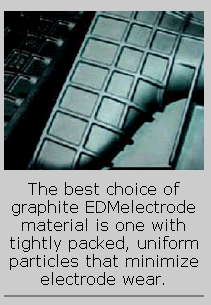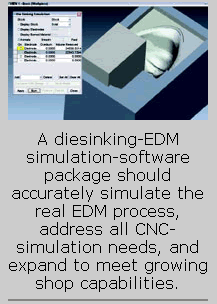An automatic wire threader fails, halting overnight production on an EDM and delaying a rush job from shipping the next morning. This common scenario illustrates why shops looking to purchase an EDM must evaluate every individual component in the system. They should be concerned with the reliability, accuracy, flexibility, and production value of the machine’s structural elements, power supply, control functions, dielectric unit, automatic wire threader, and automation.
shipping the next morning. This common scenario illustrates why shops looking to purchase an EDM must evaluate every individual component in the system. They should be concerned with the reliability, accuracy, flexibility, and production value of the machine’s structural elements, power supply, control functions, dielectric unit, automatic wire threader, and automation.
To begin the machine-evaluation process, P.J. Naughton, marketing manager at Sodick, suggests shops inquire as to a machine’s weight and its casting materials, whether or not features such as glass scales (for enhanced positioning accuracy) are standard or optional, and if options are retrofittable. Greg Langenhorst, manager of EDM sales engineering at Mitsubishi EDM/Laser, further advises looking for machines that reduce downtime by providing easy access to areas that need to be cleaned and maintained.
Experts at Agie recommend purchasing from EDM builders using only high-quality components for mechanical accuracy. Also, shoppers should consider a modular-design EDM, which lets the OEM better match customer wants and needs, and one with all structural components integrated onto a single support frame to take up less floorspace.
While EDM, for the most part, is noncontact machining, the process does generate forces unrelated to material removal. High-pressure flushing on a wire EDM and massive hydraulic pressures (or suction) caused by a diesinking EDM electrode both influence machine performance and accuracy.
Fast jump, or cycling speeds, and quick servo acceleration over small distances on today’s diesinking EDMs demand a rigid, vibrationdampening machine design, says John Shanahan, product manager at Makino. These faster speeds generate more friction and heat, so shops should look at the size and containment of a machine’s ballscrews and linear guides, along with their overall mass.
"Ballscrews with recirculating ball bearings and double-nut construction supported at both ends maintain necessary rigidity for increased machine speeds," points out Don Moulton, a regional sales manager for Ona America. Another important consideration EDM shoppers face is whether to choose machines using conventional ballscrews or linear-motor technology. Linear motors, whether incorporated into sinker or wire EDMs, provide several benefits. They simplify machine design by eliminating moving parts, ballscrews and couplings (so there’s no backlash), and metal-tometal contact. They provide smooth, vibration-free movement, high axis speeds and accelerations, and accuracy and repeatability when paired with linear glass scales.
When it comes to machine speed, Naughton says shoppers should think in terms of " realworld" cutting speed. "There are a lot of inflated speed claims, and shoppers can easily wade through them by simply having the OEM demonstrate a machine’s top cutting speed (without wire breakage) for 1 or 2-in. D2 material using 0.010-in.-diameter brass wire." While high-speed EDMing is appealing, Makino’s Shanahan warns that it can quickly become unprofitable and expensive. "If a shop is planning to use 0.0130.014-in.-diameter special brand-X wire to cut at a machine’s advertised speed, it had better make certain that the cost of those speeds is worth it in terms of overall production value."
If high speed is the choice, he suggests a machine with a rigid mechanical structure that withstands higher-than-normal flushing pressures associated with high-speed EDMing. High flushing pressures can deflect a machine’s upper and lower heads, causing a poor-quality roughing pass. This increases the number of necessary finishing passes and, thus, reduces the initial advantages of high-speed cutting.
Shanahan adds that "shorter cycle times are only advantageous if maintaining operating efficiencies. Highspeed EDMing can cost as much as 2 or 3 that of normal operating cost. For instance, large-diameter wire costs more per pound and runs out faster than standard sizes. In some cases, shops lose profits because of the increase in consumables." With this in mind, he suggests wire-EDM buyers demand an estimate of the recommended consumables, spare-parts cost, and maintenance intervals based on machining at high speeds — and hold the OEM responsible for the accuracy of its estimate.
On the sinker side, Shanahan says that a machine’s mass and dampening qualities improve the accuracy of electrode positioning in the spark gap, which, in turn, improves machining speed and finish.
But what about submerged EDMing? A machine with submergedmachining capabilities is useful for applications that generally create poor flushing conditions. For example, cutting large tapered angles, skim cutting tall workpieces, and burning near part edges.
Wire machines without submersion can make these types of cuts, but poor flushing conditions force operators to reduce power to the wire to prevent it from breaking. This translates into slower feedrates.
Fortunately, most EDMs, both wire and sinker, offer some type of adaptive-control system that modifies the programmed parameters of the machine’s power supply. Such systems sense changes in workpiece thickness, flaws or voids in the material, large tapers, and poor flushing conditions. They then automatically adapt to these conditions without operator assistance. For wire EDMs, such adaptivecontrol capabilities reduce wire breakage and improve part geometry, surface finishes, and reliability of unattended operation."These intelligent-process controllers eliminate bad sparks before they discharge and cause pitting in the workpiece," explains Stan Kutin, president of EDM Solutions. Most include on-board databases of proven power settings for various material and wire types, which eliminate timeconsuming-test cuts.
For sinker-EDM shoppers, OEMs offer similar intelligent-type power supplies for fast machining, low electrode wear, and repeatable machine performance. They control the EDM process as close to the spark as possible using processdedicated computers — high-speed processors, some as fast as 30 million instructions/sec. Other sinker-EDM adaptive systems optimize erosion of small and deep cavities and provide quick and smooth pulsation on large work surfaces and in no-flush conditions. "Purchase plenty of power," advises Kutin. "Thin, deep, noflush ribs, for instance, require short duty cycles, high peak current, and long off-times, so a shop should have enough power to finish such jobs in a realistic amount of time."
Controls and functions
Sodick’s Naughton presents several questions to evaluate EDM controls for reliable unattended machine operation. Can a shop remotely monitor the machine’s control? Can they program on-line, and can the machine be networked? He also recommends EDMs that import 3D CAD files directly into their controls to eliminate programming errors.
Most OEMs offer off-line control access through standard ethernet connections. This lets users not only monitor and run the machine from a remote location but also tap into local applications and service agents for real-time support.
Kutin of EDM Solutions adds that a wire EDM’s down-loading and programming capabilities should make purchasing post processors unnecessary.
He further recommends machine controls that handle software updates to prevent obsolescence.
EDM shoppers may also want an OEM that uses the same control on both its wire and sinker EDMs, suggests Agie. This reduces the learning curve and boosts the flexibility of operating personnel.
According to Makino’s Shanahan, today’s controls offer many functions that make an EDM-operator’s life easier, all of which are enhanced with the integration of Windowsbased operating systems.
For instance, one sinker-EDM control suggests ideal electrode undersize, rationalizes the number of electrodes needed, and organizes job sequencing according to preset priorities. Machine status transmits to operators, and the control automatically creates full reports for job evaluation.
Control functions that speed machine setup may include assist programs that automatically find part edges, vertically align the wire (for a wire EDM), and perform internal and external centering routines.
Other setup functions may involve a probing system that checks the top surface of a workpiece and programs the angle of the wire to match the A/B angle of the workpiece. After which, the wire picks up a specified side surface, and the system rotates the program to match the C skew of the part. According to one OEM, such a function saves an average of 20 min/part as compared to traditional methods of workpiece setup.
Another useful control function EDM shoppers should consider is one with a multiple-coordinate system. With these, shops set up several jobs on one machine’s worktable, and the system stores the separate job locations in specific coordinate registers.
Within a multiple-part-setup function, shops may want EDMs that let them easily highlight several job files for linking multiple workpieces in a single job. This should not involve external-CAM programming or time-consuming command files. Agie further suggests getting an EDM that allows operators to pause a job in progress, insert and machine another hotter job, and automatically return to the original one.
Also recommended for wire-EDM shoppers are corner-control functions. Such functions shorten overall erosion time without sacrificing part accuracy when cutting sharp corners and small radii. They maintain maximum cutting speeds at specified accuracy by automatically and dynamically adjusting the wire path to compensate for drag and to optimize process parameters based on material type and thickness.
On the sinker-EDM side, a control setup function to look for is one that automatically or manually measures workpiece and electrode positions in 2D space using a measuring probe. Such a function should also measure workpiece and electrode distortion around the C axis and then record and correct it.
Another recommended diesinking machine function is one for orbiting. These should provide 2D and 3D orbital movements that are usable in any plane to eliminate the need for resetting the workpiece. These functions usually include required preprogrammed shapes such as cylinder, circle, widening cone and sphere, closing cone and sphere, rectangle, rectangle with radii, star-shaped widening, and more.
Agie experts additionally suggest some type of electrodemanagement control function that automatically de-classifies and then re-classifies electrodes from finisher to rougher and adds new finishing electrodes as they wear. This eliminates geometry errors caused by electrode wear and provides savings in multiplecavity applications.
Automatic wire threading
In some instances, a reliable and low-maintenance automatic wire threader (AWT), as opposed to high-speed-cutting capabilities, can maximize a wire EDM’s throughput, says Shanahan of Makino. He recommends that shoppers purchase a machine offering AWT as standard and inquire as to the system’s cycle time, not just its insert time.
Besides letting users automatically cut multiple openings in a workpiece, a reliable AWT is practically a must for unattended wire-EDM operation. According to Ona’s Moulton, shops can set up and cut multiple jobs overnight or during a weekend without operator intervention.
AWT cycles initiate via program command or if the wire breaks in mid-cut, and there are different ways of re-threading the wire. For instance, some systems use an annealing process to separate the wire, which leaves a needlelike point on the supply end.
After annealing, a narrow jet stream of water directs the supply wire into the lower guide. The wire then engages with a wire chopper that discards the segments into a wire bin.
Other AWT systems rely on special guides with multiple points of contact to eliminate the need for annealing. These guides provide a zero-clearance condition for accurate threading that uses only a high-pressure waterjet. Such systems boast less mechanical components and, thus, higher reliability than ones without such guides.
Dielectric fluid and filtration
Wire EDMs use deionized water as a dielectric medium, as opposed to sinker EDMs, which use oil. Most dielectric systems include a water reservoir, filtration arrangement, deionization system, and water chiller.
"Though not all that glamorous, a reliable EDM dielectric system is important to overall-machine throughput," explains Shanahan of Makino. "Filtering out machining debris and maintaining a clean spark gap maintains cutting speed and part surface finishes."
Dielectric temperature also impacts machining speed and part accuracy. Since EDMs cut with an electrical current, electrical resistance of the workpiece increases temperature in the work area. High temperatures slow a machine’s ability to discharge current and, thus, its machining speed. With this in mind, Shanahan warns shoppers not to purchase machines without dielectric chillers.
He further suggests shops consider dielectric additives, some of which reduce finishing times by as much as 50%. Such additives improve a wire-EDM generator’s ability to discharge evenly in tight gaps through a conductive medium.
As compared to sinker EDMs, wire machines require more maintenance, and a large part of that involves dielectric-system-filtration units, which should be reliable, efficient, long lasting, and easy to maintain. One filtration system, in particular, incorporates mineral filters and backwashing cycles for maintenance-free, lifetime operation. After completing a preprogrammed number of automatic backwashing cycles to clean filters, this system empties solids into a sludge bag.
For sinker EDMs, shops should consider running dielectric oils that have high flash points without sacrificing flushing qualities or resorting to a thicker formula. OEMs recommend shoppers consider food-grade oils that improve flushing, contain no chlorinated solvents, and are colorless and odorless. They also deliver high dielectric strength to reduce recast layers on part surfaces.
Automation
How easy is it to incorporate a machine into workcells supported by robotic systems, and does it run as either a master or slave? These questions, according to Mitsubishi’s Langenhorst, are the first ones customers should ask when considering automation along with their EDM purchase. And to ensure the automation system is reliable, shoppers may want to consult EDM OEMs that team up with automationequipment manufacturers.
On some EDMs, controls can be moved to accommodate different automated-cell layouts. Locating controls on the left-hand side of a machine, for instance, allows for a cell layout consisting of two machines facing forward with a robot loader in between, which makes cell operation easy and conserves floorspace.
Besides the EDM, most cells typically include a changer robot and magazine units. Changer robots load and unload electrodes and workpieces in and out of machines. Magazines, which are usually bookshelf or revolving type, store both electrodes and workpiece setups/pallets.
Most automation experts recommend modular magazines that let shops start out small and add units as workloads increase. They also suggest workholding systems that make it possible to fixture parts/electrodes once and pass them from one machine to the next.
Electrode material and wire
Diesinking-EDM electrode-graphite manufacturers use different processing techniques, source materials, and
 process controls — meaning end products are also quite different. To aid customers, graphite manufacturers generally publish technical specifications on their materials along with photomicrographs of grade microstructures and performance data. According to material specialists at Poco Graphite in Texas, these are important tools for selecting a reliable graphite material, which can be tricky since various grades appear similar but perform differently depending on the application.
process controls — meaning end products are also quite different. To aid customers, graphite manufacturers generally publish technical specifications on their materials along with photomicrographs of grade microstructures and performance data. According to material specialists at Poco Graphite in Texas, these are important tools for selecting a reliable graphite material, which can be tricky since various grades appear similar but perform differently depending on the application.
While there are five grade classifications for EDMelectrode graphite, Poco suggest using one with small, uniform, tightly packed particles. Such graphite minimizes electrode wear.
After particle size, important graphite properties are flexural strength and hardness. Poco recommends choosing a graphite with flexural strength above 10,000 psi to resist machining pressure during electrode fabrication and deflection from flushing in the EDM tank. For hardness, it says the most machinable graphite materials are those between 75 and 55 on the Shore scale.
Shops looking for EDM wire have a vast array to choose from, with brass wire being the most common first choice. However, thick or thin-layered-composite wires are available, as are molybdenum, tungsten, and other types for different applications.
Wire manufacturers usually recommend zinc or layered wire for optimizing cutting speeds and soft brass wire for large tapers. High-tensile-strength types work well when using small-diameter wire, and a good flushability wire aids in cutting thick workpieces.
Simulation software
A diesinking-EDM simulation-software package should accurately simulate the real EDM process, address all CNC-simulation needs, and expand to meet growing shop capabilities.
When shopping for a diesinking-EDM simulationsoftware package, shops should ensure the package accurately simulates the real EDM process, addresses all CNC-simulation needs, and expands to meet growing shop capabilities.
Tooling manufactures shopping for simulation software should ask a couple of questions, states Jeff Werner, marketing communications director for CG Tech. Can the software perform multi-axis operations, support multiple setups, and simulate complex tool shapes? Also, does it model fixtures and holders and accurately simulate the control’s specific M and G codes and all control features used in programs?
Another factor to consider is the software’s ability to go beyond a simple visual check. It should provide accurate in-depth model analysis, automatically detect gouges and excess material left on parts, and simulate each of a shop’s machine tools for collision checking. And most importantly, emphasizes Werner, the same control logic that drives the real machines must drive simulations.
AM Mfg. Co.
In considering EDM for an upcoming job, AM Mfg. Co. plans to evaluate both wire and sinker systems. A wire EDM could cut basic O.D. profiles for the job, but not the intricate cavities called for in the part surfaces. For this reason, the shop is focusing on sinker EDMs.
To handle the job’s high volumes, AM Mfg. will most likely run the machine it chooses unattended overnight and on weekends. So remote-monitoring capabilities and automated electrode/workpiece loading are musts. The shop is also looking into workholding systems that will allow it to pass electrodes from a milling machine to the EDM and workpieces from other machine tools to the EDM.
ACKNOWLEDGMENTS
ACKNOWLEDGMENTS AMERICAN MACHINIST would like to thank the following for their contributions to this article:
- Agie Ltd., Lincolnshire, Ill.
- CG Tech, Irvine, Calif.
- Charmilles, Lincolnshire, Ill.
- EDM Solutions Inc., Elk Grove Village, Ill.
- Makino, Mason, Ohio
- Mitsubishi EDM/Laser, Wood Dale, Ill.
- Ona America Inc., Dayton, Ohio
- Poco Graphite Inc., Decatur, Tex.
- Sodick Inc., Schaumburg, Ill.
Reprinted by permission from American Machinist Magazine.

